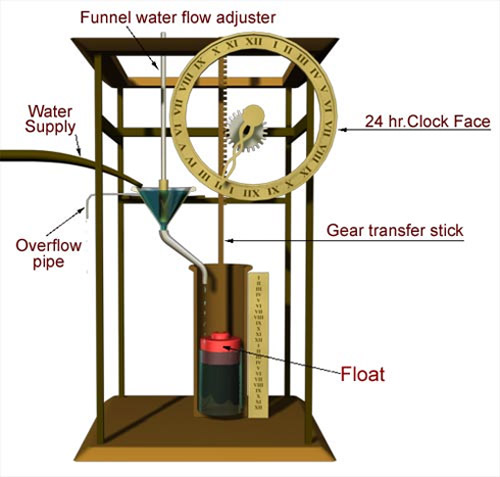





If you were looking for reliable and accurate measurements over millions or billions of years would you seriously be looking at candle and water clocks? Candles, when used as clocks, were placed for protection inside wooden cases. Methods of measuring time like these were used in medieval churches and earlier, famously by King Alfred the Great of England, first by counting the number of candles of a specific size burnt, and later by use of a graduated candle. They were protected from outside influences, like a draught which could have slowed the rate of burning or extinguished the flame. Then there is the obvious constraint that these measurements of time had to be of comparatively of short duration. This is obviously diametrically opposite to the long ages given to radio-metric dating. Ages during which various forms of contamination and interruptions could have interfered with the accuracy of any measurements taken, and done so unseen and unnoticed. Scientists have no accurate idea at all about the initial state conditions that determine radio-metric decay rates. So to use the candle analogy. Just how big was the candle when it began burning, and was it ever blown out, and if so when was it relit. The problems are truly mountainous unless the process was not being measured and checked at regular intervals, as would have happened at the time of Alfred the Great. The same difficulties apply with water clocks. Has the hole in the tank been widened or narrowed or become clogged by debris? Has water ever been added or subtracted from the tank and so on?
Richard Dawkins with his characteristic desire to illustrate complex issues with easily accessible imagery has helped enormously to clarify the issues. There is no way he would have chosen the water and candle clocks as examples of how the radiometric dating process works if these were poor examples. And yet taking him at his word, and the candle and water clocks as analogies, graphically illustrates the potential fault lines inherent in this process. A process which is presented almost as a credo: a fixed, reliable, constant, certain and repeatable dating method that has come close to ruling serious error out of its equations. This can now be seen as clearly false.
This matter of how the geology of the earth was formed is entirely governed by conjecture, the timescale given rules out the possibility of human observations. The hundreds of millions of years are vital components of the evolutionary theory which needs vast periods of time. Empirical evidence is lacking because the conclusion was set in stone without either direct observation or experimentation.


Most people think that radiometric dating has proved the earth is billions of years old. Just because scientists observe unstable atoms changing into stable atoms at a certain rate in the present does not necessarily mean that the rate of decay has always remained the same. Scientists, like any one of us, can run into big problems when they make assumptions about what happened in the unobserved past, in this case pre-history.
These methods may be reliable, but who can say for sure? They depend on so many factors, some of which are unknowable. Most crucially, what were the initial states governing radiometric decay when the process began? Under what conditions did it begin, and have these remained constant? Has the clock ever stopped and been restarted, has contamination or leeching ever occurred and so on? And suppose, for the sake of argument, something astonishing happened. Something on the scale of a global tectonic, volcanic upheaval, accompanied by a collapse of the then existing environment, a worldwide flood and a following Ice Age; then what? These small matters could be overlooked if the radiometric dating method, which always seems to turn up dates that make the Bible look stupid, didn't conflict with another dating method: Carbon 14 which often turns up dates which make the Bible chronology seem reasonable.

To be fair, this issue is extremely complex. There is however reason to be sceptical about any process that claims near infallibility when looking back at ages which we cannot even properly comprehend. What does it mean when a date of 103.6 million years, give or take a few million either side, is published? It is meaningless in the sense that no-one can either contradict or confirm the data. These dating methods are given over-arching authority, but given the doubts about reliability and accuracy, the questions that arise can never be fully settled. If this form of establishing a fact was comparable to say DNA profiling then evolutionists would have a point. But there is no likeness between the two. There are ways of testing whether a DNA sample proves or disproves something. There is no way this can be done with radiometric dating methods. A palaeontologist looks at a range of possible dates from a number of dating processes and either rejects the lot or accepts the one closet to the required date. The required date may have been specified by the rock layer in which a fossil has been found. Or alternatively the fossil could decide the matter of the age of the rock. Hence it is not necessarily the rock that is being been dated. If the palaeontolgist knows the fossil is a sabre toothed cat then the probable date of the rock within certain parameters is known, established by the fossil. Any date which contradicts the known date of the fossil will just be rejected. Is this good science?
The long age model has never been proved, it has just been assumed. Any evidence by way of fossils that are discordant will be explained away. As will unconformities (missing rock layers) and mountains being moved and shunted on top of another rock formation by forces that leave no trace on the ground. No evidence seriously questions the theory, it will be made to conform; and having been interpreted according to the current orthodoxy, serve to bolster the underlying assumptions of the theory. And that, at least in part, is the dating game.
But there is more! The following is from The Magic of Reality by Richard Dawkins
‘Briefly, a radioactive isotope is a kind of atom which decays into a different kind of atom: for example. one called uranium-238 turns into one called lead-206. Because we know how long this takes to happen, we can think of the isotope as a radioactive clock. Radioactive clocks are rather like the water clocks and candle clocks that people used in the days before pendulum clocks were invented. A tank of water with a hole in the bottom will drain at a measurable rate. If the tank was filled at dawn, you can tell how much of the day has passed by measuring the present level of water. Same with a candle clock. The candle burns at a fixed rate, so you can tell how long it has been burning by measuring how much candle is left. In the case of a uranium-238 clock, we know that it takes 4.5 billion years for half the uranium-238 to decay to lead-206. This is called the 'half-life' of uranium-238. So, by measuring how much lead-206 there is in a rock, compared with the amount of uranium-238, you can calculate how long it is since there was no lead-206 and only uranium-238: how long, in other words, since the clock was 'zeroed.'
“Radioactive clocks are rather like the water clocks and candle clocks that people used in the days before pendulum clocks were invented. A tank of water with a hole in the bottom will drain at a measurable rate. If the tank was filled at dawn, you can tell how much of the day has passed by measuring the present level of water. Same with a candle clock. The candle burns at a fixed rate, so you can tell how long it has been burning by measuring how much candle is left.”

Water Clock Example - Imagine how many ways the clock could be made to give inaccurate readings? Radiometric Dating is in a similar way liable to all manner of ways to give misleading dates.
Radiometric Dating is a complex and specialised area and if you would like to find out more there are plenty of good articles to read on other websites such as:-
Answers in Genesis
Creation.com




- Radiometric Dating is based on so many unprovable assumptions that it really proves nothing.
- Recent dating on recently formed rocks e.g. volcanic rocks from Mount St Helens Volcano were sent to reputable dating labs and came back as being millions of years old when actually they were only formed a few decades ago.
- Dawkins use of Water and Candle clocks as analogies prove how weak and liable to contamination these methods are.

Alternatively this kind of “dating” is much more simple.



























